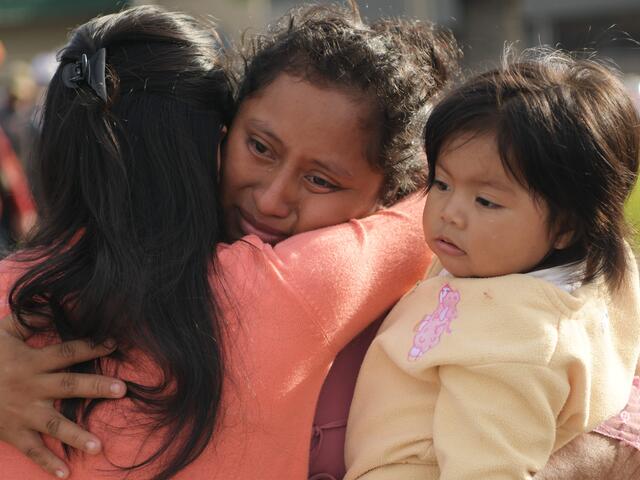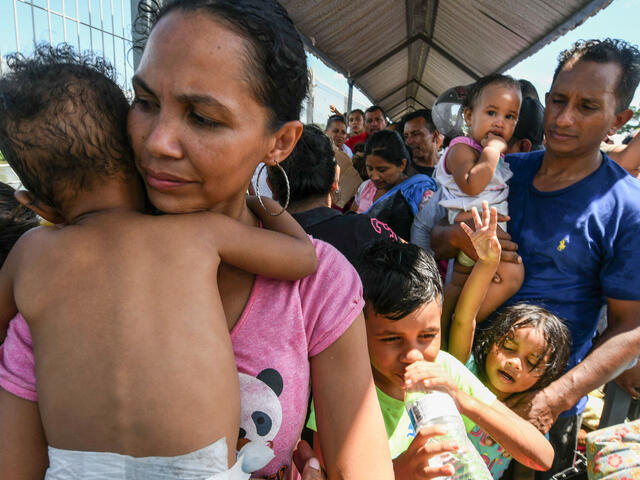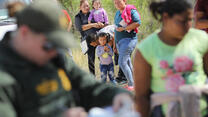Political turmoil, extreme poverty and rampant violence in Central America have fueled a humanitarian crisis. The caravans traveling to the United States border to seek refuge have brought critical attention to the horrors that are forcing individuals and families to flee.
Meghan López, who has worked in the region for more than a decade and has been leading the International Rescue Committee’s response in El Salvador since February 2018, explains the circumstances fueling the current refugee crisis and the dire situation Central Americans face in their own countries.

The decision to take this journey is not taken lightly
No parent thinks it's a great idea to take their children and walk over 3,000 miles through gang territories where there are real threats of rape, kidnapping and human trafficking—that is, unless the current reality they face in El Salvador, Guatemala and Honduras (also known as the Northern Triangle) is worse than the potential threats of the journey.
While there is no one particular profile of who is participating in the caravan, we are seeing higher than usual percentages of families, who hope that traveling in a group will make the arduous journey nominally safer. I think it’s important to stress that the decision of any one to take this journey is not taken lightly.
The most common way north is using a coyote, a smuggler paid to arrange the trip, which can cost about $7,000 … up to $12,000 for an unaccompanied minor. It’s an astronomical amount of money for locals where the national minimum wage is around $350 a month, and many people work odd jobs making less than that.
Families mortgage their homes, sell cars and crops or commit to pay exorbitant interest rates on money borrowed to pay coyotes. If someone doesn’t make it to the States, they know they are putting their entire family at risk financially and returning to financial ruin themselves.
I’ve heard parents say they feel great shame for putting their children in this situation. But they choose to do this because where they live is so scary, so desperate, that the treacherous journey is the only choice as they seek safety for their children.

'It's better than staying at home living with relentless fear'
Living under threat of violence is a pervasive aspect of life in El Salvador, Guatemala and Honduras. Many people in these countries live in communities that are controlled by criminal gangs. Nearly 10 women and girls are killed every single week in El Salvador. The country has one of the highest rates of murder per capita in the world outside of an active war zone, and yet for many people who live here it feels as though it is an active war zone.
Parents are making difficult choices every day to protect their loved ones, and the mental toll, the level of toxic stress this generates, is immense. Imagine if every aspect of your life was based on a careful and constant calculation of what the level of risk and imminent harm might be.
Should I leave to run errands at this time? No, the gang members are still active. Can I ride that bus that goes through that neighborhood? No, I’m from a neighborhood that is controlled by an opposing gang and if seen, they may assume I am a spy and threaten my life.
Parents not only have to worry for their own safety, but they worry constantly for their children—young boys who are forced into gang activity as early as age 6, daughters who are at risk of sexual violence or coerced relationships—a threat that gangs hold over parents. As a parent, I find these stories of forced recruitment the most harrowing. If children refuse the gangs’ demands, that can mean death for them and their families.
If you’re constantly thinking about all of the possibility of violence and threats against you and your family, it’s mentally exhausting. What else can you do but get out? No one thinks it’s a good plan, but it's better than staying at home living with relentless fear.

Salvadorans’ stories: overcoming horrific challenges
In 2017, nearly 300,000 Salvadorans left the country. The IRC has witnessed first-hand the vulnerabilities of those who are forced to flee and seek safety in the U.S.
Last year, we conducted an assessment that showed that the more often Salvadorans were displaced internally, the more likely they were to flee to the U.S. Many of those fleeing to the north have already tried multiple times to restart their lives here in El Salvador—to no avail.
Maria* was an unaccompanied minor who journeyed north after the gangs in her community became increasingly aggressive in trying to recruit her into activities under the guise of being a “girlfriend” against her will.
She traveled in a group of girls all aged 12-17 with a coyote. On their journey leaving El Salvador, they walked at times on open roads and back trails in the night as well as traveling in an airless, overcrowded truck with no food, no water, and no place to sit. Several of the girls in the group were raped. When Maria reached the border, she was picked up by the U.S. border patrol and deported back to El Salvador. She was not given the chance to seek asylum.
These families will not be deterred from fleeing, because there is no scarier place than their homes right now.
When Maria returned to El Salvador, she and her family moved in with her aunt in a safer neighborhood. They received a range of assistance through a government program supported by the IRC. That meant Maria was able to attend counseling sessions to cope with her terrifying experiences fleeing the gangs. Her family also received cash support from the IRC to help them re-establish themselves in their new community. Maria and her mom were able to start a small business together, and Maria has re-enrolled in school to get her high-school degree.
Carlos* was forced to join a street gang in El Salvador. He escaped to the U.S., where he was detained at the border and lived in detention for over a year. He can’t return home because his brother, who lives with his mother, is heavily involved in the gang he has hoped to escape. Now back in the country, he has no other family members, is living in hiding and is fearful of what could happen to him for leaving the gang. His case is very difficult and sensitive, but the IRC is working with a number of local partners to give him short-term cash assistance and connect him to other resources to help him reintegrate back into the community safely, though now in a new location.
These stories speak to me about the impact of the IRC’s work in Central America and give me hope that there are ways for people to overcome horrific challenges and harrowing situations, that our programs can make a real difference.
But this situation isn’t something that will end quickly. These families will not be deterred from fleeing, because there is no scarier place than their homes right now. The crisis will end only if we invest in an effective, long-term response that addresses the root of the problems, and this includes staying true to our American values, to what we stand for as a welcoming country.
The IRC in El Salvador
The IRC was one of the first international organizations to declare a humanitarian crisis in El Salvador. We provide emergency assistance for the most vulnerable Salvadorans, and have already reached more than 820 people with cash support. We launched CuéntaNos, an interactive platform with trustworthy, up-to-date-information about services that has received 40,000 visits. In addition, the IRC has trained more than 700 local partner organizations to provide critical services to individuals and families in crisis. Learn more.



